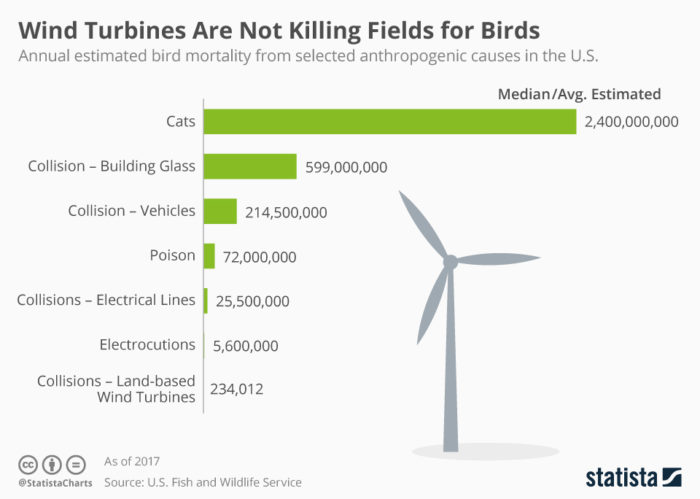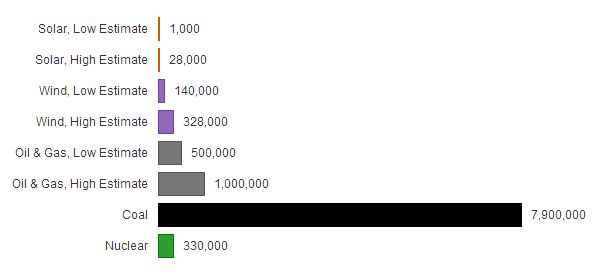Jan 02 2020
Update On Wind Turbines and Birds
 Objective numbers are great for any debate or discussion. They have a way of cutting through all the subjectivity, confirmation bias, and nonsense. I like to say – you can’t argue with the numbers – but of course, I know that people still do. More importantly, they straight up ignore, deny, or distort the numbers, painting an alternate reality at will. But for those who still care about data and facts, here are some recently updated numbers on bird deaths from various sources.
Objective numbers are great for any debate or discussion. They have a way of cutting through all the subjectivity, confirmation bias, and nonsense. I like to say – you can’t argue with the numbers – but of course, I know that people still do. More importantly, they straight up ignore, deny, or distort the numbers, painting an alternate reality at will. But for those who still care about data and facts, here are some recently updated numbers on bird deaths from various sources.
This story is in the news again because Trump recently renewed his attack on wind turbines. Pretty much everything he said was wrong or significantly distorted, as others have pointed out. I want to focus on his previous claim that wind turbines, “kill all the birds.” He recently added:
“You want to see a bird graveyard? You just go, take a look, a bird graveyard, go under a windmill someday you will see more birds than you ever seen, ever in your life.”
This is, of course, hyperbole, but I don’t think that excuses his lack of precision and context. He is making a clear point – we should oppose wind turbines in part because they cause an unacceptable number of bird deaths. Look at the chart above – this makes it visually clear that the number of bird deaths from wind turbines does not even register when compared to other sources. It is less than the uncertainty in other sources of bird deaths. In fact, if anything the chart visually underestimates the difference because you can’t really even see how small the total from wind turbines is.
The number of bird deaths from cats is most impressive. This comes from National Geographic who report:
“Several years ago, a team of Smithsonian Institution and U.S. Fish and Wildlife Service researchers combined data from dozens of previous studies to estimate, as rigorously as possible, how many birds are killed by cats each year in the contiguous United States. Their results were startling. After carefully quantifying cat populations and predation rates (and the uncertainty of both), the scientists calculated that domestic cats pounce on one billion to four billion birds a year in the lower 48 states, as well as 6.3 billion to 22.3 billion small mammals and hundreds of millions of reptiles and amphibians.”
They estimated the rate at 2.4 billion, which is where the Statistica chart got its number, but really the range is 1-4 billion. That’s four orders of magnitude greater than deaths from wind turbines. Deaths from glass buildings is also impressive at 600 million. If we add up all the recorded sources of bird deaths, wind turbines are responsible for 0.0072%. We could save more bird lives by putting stickers on windows, or controlling our feral cat population (about two thirds of the cat-related deaths are from feral cats).
 Here is another way to put this phenomenon into perspective – the relative number of bird deaths from various energy sources. As you can see, air pollution kills far more birds than wind turbines, even at the high estimate. Anyone truly concerned about the impact of our energy infrastructure on bird populations should be very worried about coal-fired plants. Actually, a far better way to state these statistics is birds killed per killowatt hour. I have those numbers too:
Here is another way to put this phenomenon into perspective – the relative number of bird deaths from various energy sources. As you can see, air pollution kills far more birds than wind turbines, even at the high estimate. Anyone truly concerned about the impact of our energy infrastructure on bird populations should be very worried about coal-fired plants. Actually, a far better way to state these statistics is birds killed per killowatt hour. I have those numbers too:
“Wind farms and nuclear power stations are responsible each for between 0.3 and 0.4 fatalities per gigawatt-hour (GWh) of electricity while fossil-fuelled power stations are responsible for about 5.2 fatalities per GWh.”
So coal kills about 15 times as many birds as wind per kilowatt hour. This means that wind turbines that displace fossil fuel as a source of energy production actually save bird lives. There are some caveats to these numbers, which are detailed in the linked articles. Not all the estimates are equally up to date and they use various methods. But given that each is a reasonable estimate, it’s unlikely that any methodological differences will flip the relative bird killing potential of the various energy sources.
As a matter of logic, I also want to point out that there are downsides to all sources of energy (or pretty much anything). You cannot just point out a potential negative as if the only reasonable conclusion is that therefore we must oppose that option. That is a biased propaganda approach, not a fair or logical approach. You have to ask the further questions – how does this downside compare to the other options, and is it a deal-killer or can we manage it? Overall what is the risk vs benefit. I think a more thorough look at all the numbers puts the bird-killing potential of wind turbines into perspective – it is insignificant compared to other sources of bird deaths, and it is far less than burning fossil fuels.
It’s also a manageable problem. I am not arguing that we should ignore the effect of wind turbines on birds and bat populations. Some states have regulations in place to analyze the potential impact of new wind turbines on birds and bats. A legitimate concern is the effect on predator birds, whose numbers are relatively low to begin with, so killing even small numbers can be a problem. There are already methods, both proposed and enacted, to minimize turbine-caused bird deaths. These include where to place the turbines, the shape of the blades, their color, using radar to detect incoming birds, turning off in low wind, and using ultrasonic deterrent.
Numbers are important. They can tell an important story, and they have the virtue of being, by definition, quantified. The more objective, transparent, and verified the numbers the better. It’s also important to look at all the relevant numbers, not just cherry pick the ones you want. This is part of what makes scientific thinking so powerful.






